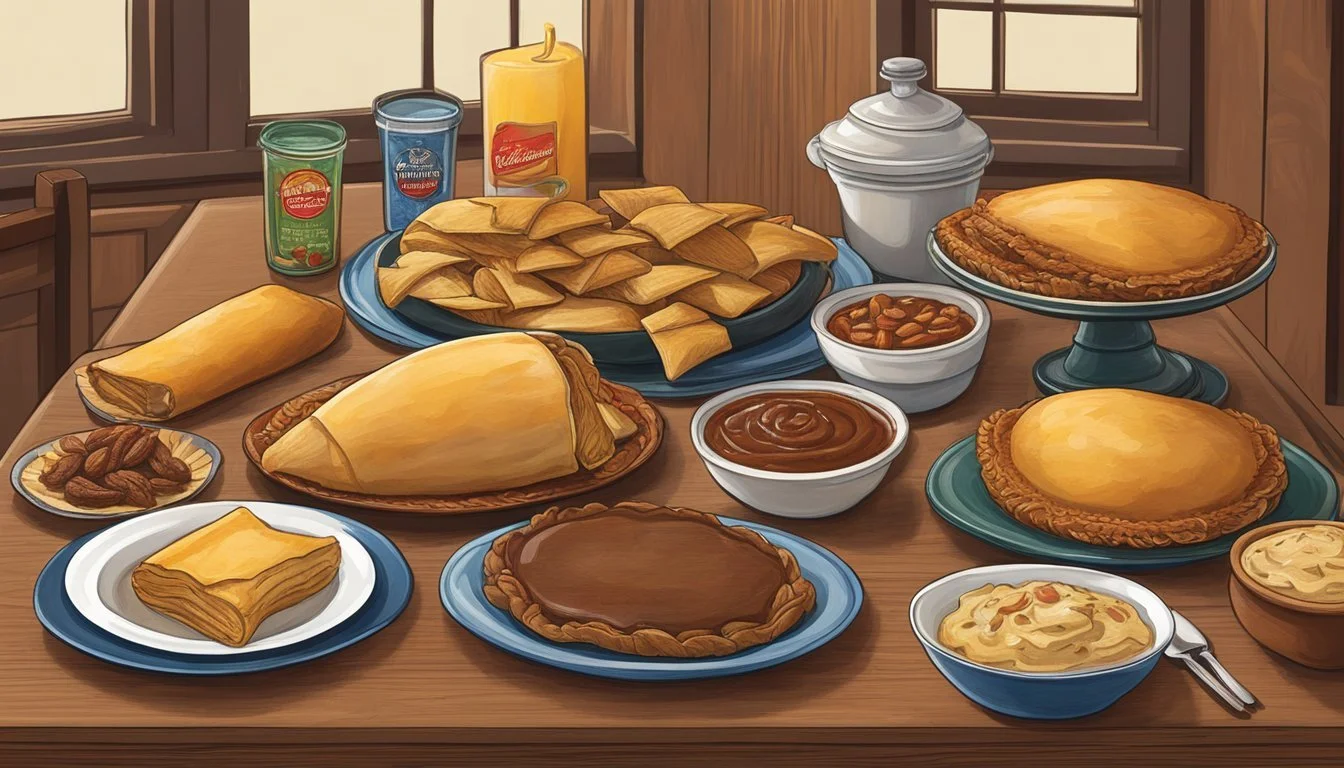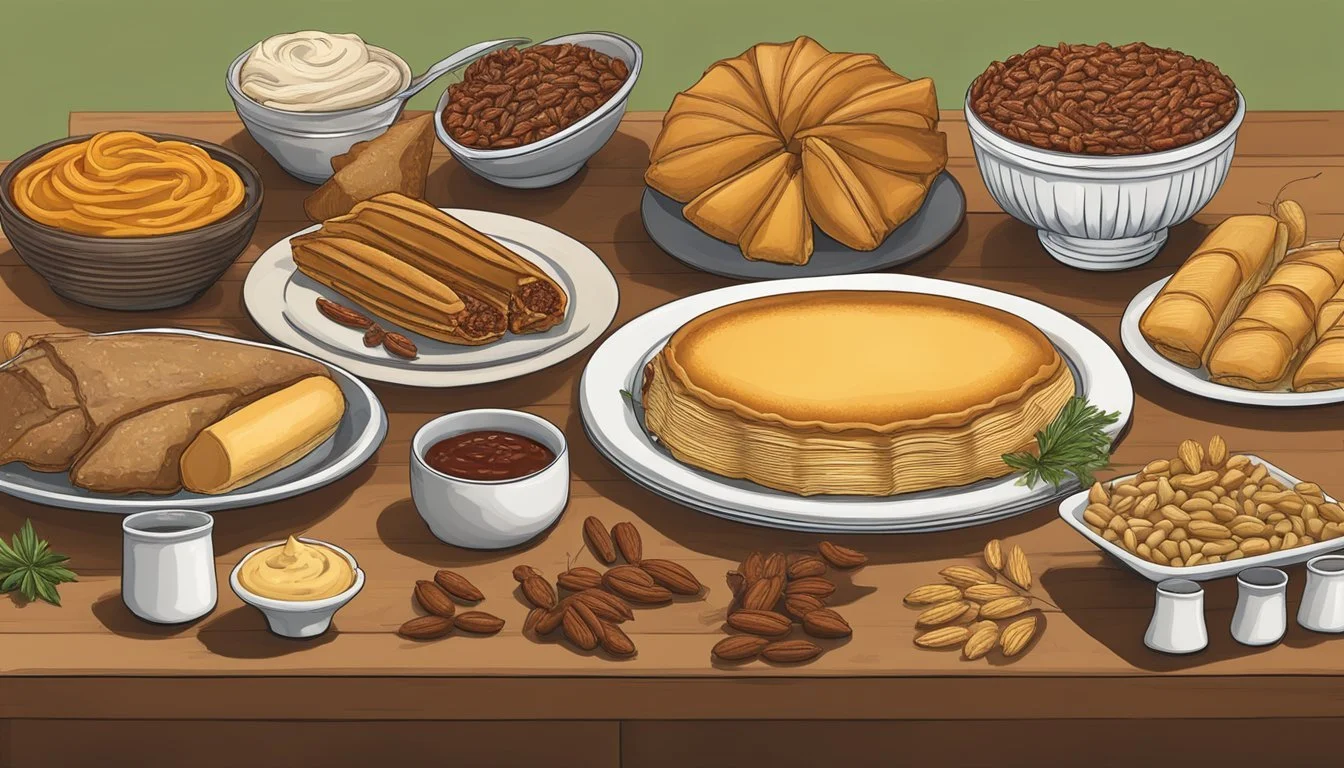5 Texas Food Traditions for the Holidays
A Culinary Celebration
The holiday season in Texas is a time when culinary traditions take center stage, reflecting the state's unique blend of cultural influences. From hearty main dishes to sweet treats, these food traditions are cherished by families and communities, creating a warm and festive atmosphere.
Exploring Texas's holiday food traditions offers a glimpse into the state's rich heritage and diverse culinary landscape. Whether it's a beloved dessert or a savory favorite, each dish tells a story of community, history, and seasonal celebrations.
1) Tamales
Tamales hold a special place in Texas holiday traditions. These savory bundles are made from masa harina dough, filled with a variety of ingredients, and wrapped in corn husks before steaming. Each family might have its own tamale recipe, which can include fillings like pork, chicken, beef, or tasty vegetarian options.
Making tamales is often a communal activity that brings families together during the holiday season. Many hands contribute to the process—from preparing the masa and fillings to wrapping the tamales in husks. This shared experience strengthens bonds and creates lasting memories.
In Texas, tamales are not just holiday fare but a year-round favorite. Yet, they take on extra significance during Christmas. They are often served at large family gatherings, parties, and celebrations, acting as both meal and festive centerpiece.
Authentic tamales can be found in numerous places across Texas. Lone Star Texas Style Tamales is one business offering traditional tamales for purchase online, allowing people to enjoy this beloved dish no matter where they are. This accessibility helps keep the tradition alive and widely enjoyed.
Whether purchased or homemade, tamales remain a cherished part of Texas holiday celebrations, reflecting the state's rich cultural heritage and love for flavorful, hearty food.
2) Smoked Brisket
Smoked brisket is a cherished centerpiece in Texas holiday celebrations. Known for its tender, melt-in-your-mouth texture, this dish requires patience and precision. The process begins with choosing a quality cut of meat, often referred to as a "packer" brisket, which typically weighs between 8 to 20 pounds.
Preparation involves a dry brine, which usually takes place overnight in the refrigerator. This adds flavor and helps retain moisture. The smoking process is all about "low and slow" cooking. A smoker is preheated to around 250-265°F and enhanced with Post Oak wood chunks or chips for that authentic Texas smoke flavor.
Once placed on the smoker, the brisket will cook for several hours. It’s essential to monitor the internal temperature, aiming for an initial target of 165-170°F. This step typically takes around 7-8 hours. During this time, it's common to spritz the brisket with water or vinegar to maintain moisture.
Wrapping the brisket in butcher paper or foil after reaching 165°F helps create a seal that keeps the meat moist and continues to cook evenly. The final internal temperature should be about 205°F for optimal tenderness, a process that can take several more hours.
Smoked brisket is versatile and can be served with a variety of sides such as coleslaw, potato salad, or baked beans. It’s a staple in Texan cuisine, symbolizing tradition and the joy of shared meals during the holidays.
3) Pecan Pie
Pecan pie is a cherished holiday tradition in Texas, known for its rich, nutty flavor and sweet filling. The origins of this classic dessert are deeply rooted in Southern cuisine, where it has been a favorite for generations.
This pie features a buttery, flaky crust that serves as the perfect base for the sweet, caramel-like filling. Made with a mixture of eggs, sugar, butter, and syrup, the filling is then generously topped with crunchy pecan halves.
Baking a pecan pie involves precise steps to ensure the crust is perfectly browned and the filling is set but not overcooked. The pie is typically baked at a high temperature initially and then at a lower temperature to finish.
In Texas, every family has its twist on the traditional recipe. Some use bourbon or chocolate to add depth to the flavor, reflecting the diverse culinary landscape of the region.
Pecan pie is often served with a dollop of whipped cream or a scoop of vanilla ice cream, enhancing its delightful flavors. During the holidays, it stands out as a must-have dessert on the festive table.
4) Kolaches
Kolaches are a beloved pastry in Texas, tracing back to the 1800s when Czech immigrants brought their culinary traditions to the state. Originally from Central Europe, these pastries have found a warm home in Texas cuisine.
Traditional kolaches are made from a yeast dough and are filled with fruit, poppy seeds, or sweet cheese. In Texas, the evolution includes savory variations, such as sausage, cheese, and jalapeños, reflecting local tastes.
Baking kolaches involves letting the dough rise, shaping into balls, and filling with the desired ingredients. They are then baked until golden brown, often brushed with egg wash or melted butter to add a shiny finish.
Small towns with Czech heritage, like West, Texas, are famous for their kolache bakeries. These family-owned establishments preserve the authenticity of this sweet and savory treat.
Kolaches are not just for breakfast; they make an excellent snack anytime. Their versatility and rich flavors make them a staple in Texas, especially during holiday gatherings.
Whether you prefer the traditional sweet fillings or the Texan savory twists, kolaches offer a delicious way to connect with both Texas and Czech heritage.
5) Chili Con Carne
A quintessential Texan dish, Chili Con Carne, combines hearty beef with robust chili peppers to create a warming, flavorful stew. Originating from the Spanish Canary Islanders who settled in San Antonio in the early 18th century, the dish has evolved into a beloved holiday tradition.
Browning the meat is a vital step in enhancing the depth of flavor. The process involves searing the chuck roast or similar cuts in a Dutch oven to achieve a rich, caramelized surface. This forms the flavorful base for the chili.
Adding dried chiles is another key to achieving the distinctive taste. Toasting them gently over medium-high heat intensifies their aroma without causing them to smoke. Once toasted, they are often rehydrated and blended into a paste that contributes to the chili’s signature warmth and spice.
Onions, garlic, and jalapeños are typically sautéed in the same pot, absorbing the savory residues from the meat. The chili paste is then introduced, creating an aromatic blend that clings to the bottom of the pot before beef broth is added to deglaze and build the stew.
Originally, cowboys used dried beef and suet for this dish. Modern recipes favor fresh meat, adding depth and richness. Chili Con Carne reflects Texas' rugged history while serving as a festive dish for holiday gatherings, symbolizing warmth and community in every bite.
Historical Significance of Texas Holiday Foods
Texas holiday foods reflect a rich tapestry of influences that have shaped the region's culinary traditions. Three key forces are the Native American cuisine, Spanish and Mexican traditions, and the developments throughout the 20th century.
Influence of Native American Cuisine
Long before European settlers arrived, Native Americans in Texas had developed a deep connection with the land. They utilized native plants such as mesquite beans and prickly pear, and hunted local wildlife. Early inhabitants transformed bison, deer, and smaller game into sustenance. Techniques like roasting and drying meat were crucial for preservation. These methods and ingredients laid the groundwork for many Texan dishes that continue to be enjoyed during holiday celebrations today.
Impact of Spanish and Mexican Traditions
Spanish colonization introduced new ingredients and techniques to Texas. Corn, beans, and squash were already staples but were combined with European staples like rice, garlic, and various spices. Mexican influences further enriched the culinary landscape, bringing tamales, enchiladas, and other dishes. During holidays, these foods became central to celebrations, with tamales often being made in large batches as a communal family activity. This melding of Spanish and Mexican cuisine created a unique Tex-Mex flavor profile that defines many Texas holiday dishes.
Evolution During the 20th Century
The 20th century saw Texas cuisine incorporating new elements as a result of immigration and commercialization. African American traditions, such as barbecue, heavily influenced holiday meals. Events like Juneteenth brought foods that emphasized cultural identity and resilience. The commercialization of food, including the rise of packaged products, also changed holiday menus. Despite new influences, many traditional methods and recipes were preserved and adapted, keeping the spirit of Texas holiday foods alive and vibrant.
Regional Variations in Texas Holiday Foods
Holiday foods in Texas showcase a delightful diversity influenced by the state's vast regions. From East to West and down to South Texas, the culinary traditions reflect local ingredients and cultural influences.
East Texas Specialties
East Texas is known for its rich, comforting dishes that often come from generations-old family recipes. Famous for smoked and fried turkey, the region's holiday tables also feature classic Southern sides like cornbread dressing and collard greens. Pecan pie is a staple dessert, frequently made from locally-grown pecans. The influences of Southern cooking are evident, characterized by savory, slow-cooked meals and deep-rooted in local produce.
West Texas Flavors
In West Texas, the holiday cuisine draws heavily on cowboy culture and the rugged landscape. Barbecue, including brisket and ribs smoked with mesquite wood, lends a distinctive flavor. Chili con carne often makes an appearance, reflecting the region's proximity to the Mexican border. Side dishes frequently include pinto beans and cornbread, while desserts might feature local ingredients like peach cobbler using fruits from the vast orchards in the area.
South Texas Treats
South Texas has a strong Mexican influence, evident in holiday favorites like tamales and pozole. Tamales are especially popular, with families gathering to make them in large batches just before the holidays. Buñuelos, crispy fried dough coated with sugar and cinnamon, are a beloved dessert. The region is also known for its use of spicy salsas and avocado-based sides, which add a fresh flavor to the dishes. The culinary traditions here celebrate warmth and communal spirit, characteristic of South Texas family gatherings.






